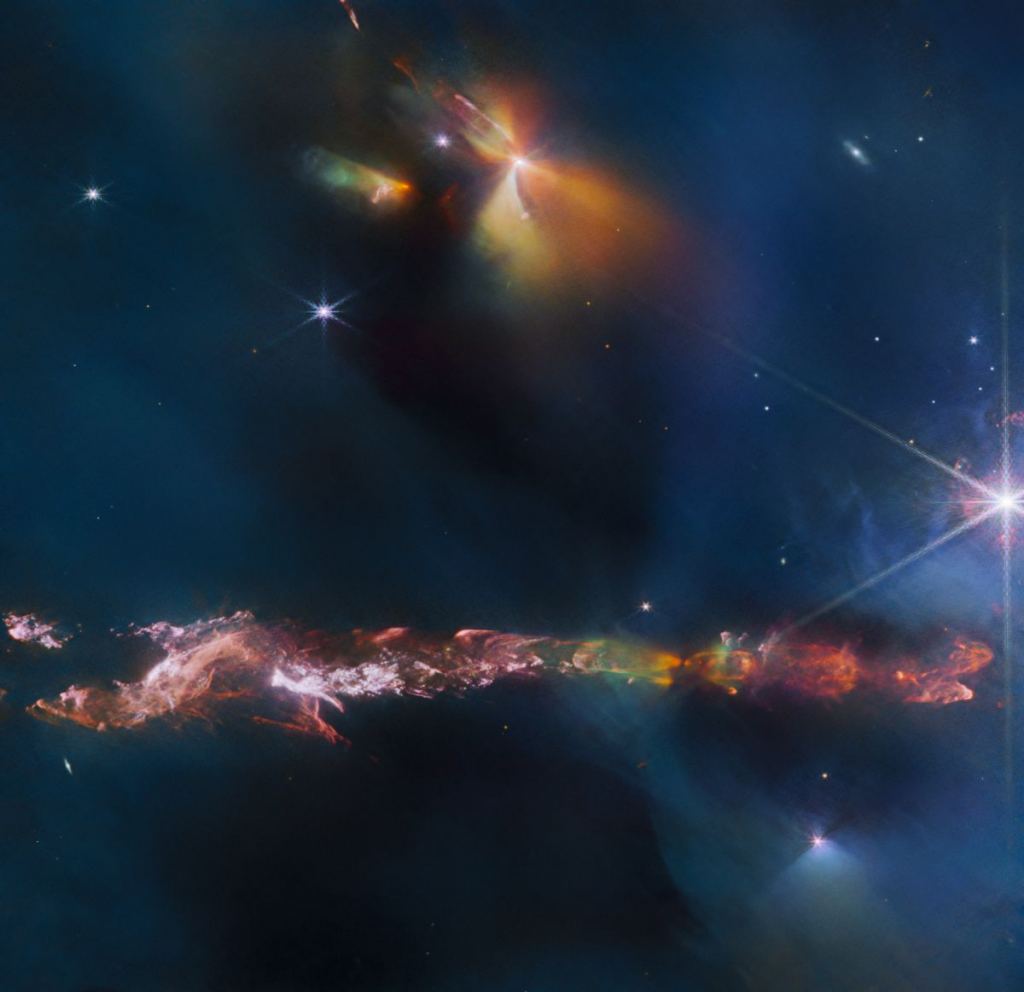As our newest, most perceptive eye on the ongoing unfolding of the cosmos, the James Webb Space Telescope is revealing many things that were previously unseeable. One of the space telescope’s science goals is to expand our understanding of how stars form. The JWST has the power to see into the cocoons of gas and dust that hide young protostars.
It peered inside one of these cocoons and showed us that what we thought was a single star is actually a binary star. The JWST’s image of the Herbig Haro object 797 (HH 797) is the telescope’s Picture of the Month . Herbig-Haro objects are luminous patches of nebulosity associated with young protostars.
These stars are still gathering mass, a stage that can last about 500,000 years. As the protostar gathers mass, in-falling gas generates shocks on the star’s surface. So, while protostars haven’t begun their life of fusion, they still release energy.
In a Herbig-Haro object, the energy that lights it up comes from twin jets of ionized gas coming from the star. Astronomers have found hundreds of HH objects in the Milky Way, and they’re common in star-forming regions. The jets of partially ionized gas travel at hundreds of kilometres per second, slamming into nearby gas clouds and lighting them up.
Most HH objects are within 3. 26 light-years (one parsec) of the protostar emitting the jets. HH objects don’t last long, only a few tens of thousands of years, which is a proverbial blink of an eye in astronomy.
Astronomers can see them visibly change as they travel away from their source into the interstellar medium (ISM). The ISM can be clumpy, and the HH can fade in some parts and brighten in others as the jets encounter more diffuse and more dense regions of gas. HH 797 doesn’t advertise itself in optical light.
Instead, molecular hydrogen, carbon monoxide, and other molecules are excited by the energetic jets and emit infrared light. The JWST was built to scrutinize infrared light like this, which brings HH 797’s details into view. The colours in the image come from different molecules present in the gas clouds.
Not only are there molecular hydrogen and carbon monoxide, but iron, methane, and polycyclic aromatic hydrocarbons —a potential building block of life—are also present. Research using ground-based observations showed that the gas associated with HH 797 is moving at different speeds. Most of the red-shifted gas moving away from us is in the bottom right of the image.
But most of the blue-shifted gas moving toward us in the bottom left. Research also found a velocity gradient across the gas so that at any given distance from the star, the gas on the eastern end of the red-shifted jet is more red-shifted than the gas on the western edge. Astronomers chalked it up to rotation in the outflow.
But with its exceptional infrared acuity, the JWST has revealed a second protostar hiding inside the gas and dust. So what astronomers thought was a single outflow is actually two parallel outflows with their own shocks coming from two separate stars. So the velocity asymmetries are because astronomers were actually measuring two different outflows.
The source is in the bottom right small dark region, and the JWST image shows that it’s, in fact, two sources. So rather than a single protostar being responsible for what we see, there are two protostars at work. This shouldn’t come as a surprise.
As many as half of the Milky Way’s stars are in binary pairs or even multiple groups. It only makes sense that some of the HH objects we can see are, in fact, binary HH objects. Thanks to the JWST, we can HH 797 to the list.
.
From: universetoday
URL: https://www.universetoday.com/164514/jwst-reveals-a-newly-forming-double-protostar/



